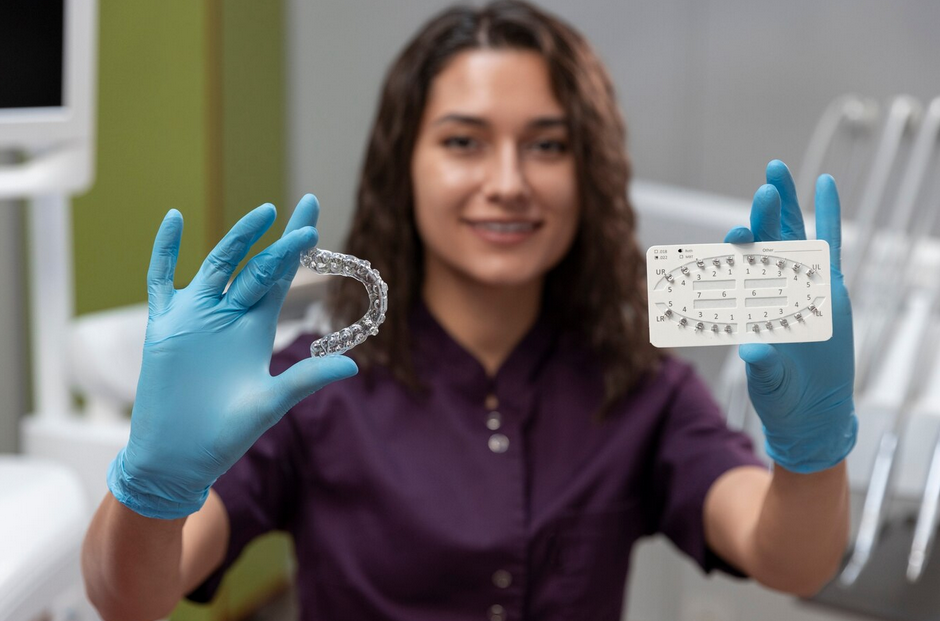Clear aligners have taken the world of orthodontics by storm, offering a discreet and comfortable alternative to traditional metal braces. But while Invisalign is the most recognized brand in this category, many other clear aligner systems—such as ClearCorrect, Byte, SmileDirectClub, and Candid—are now available. This leads to one important question for patients: What’s the difference between Invisalign and other clear aligners?
Below is a comprehensive breakdown to help you understand how Invisalign compares to other clear aligner brands and what makes it unique.
1. Brand vs. Category
✅ Invisalign:
- A specific brand of clear aligners developed by Align Technology, introduced in 1997.
- Uses patented technologies like SmartTrack® material and ClinCheck® 3D planning software.
✅ Other Clear Aligners:
- A category of aligner systems that includes brands like ClearCorrect, Candid, Byte, SmileDirectClub, etc.
- Vary in quality, technology, and treatment method (some are dentist-supervised, others are direct-to-consumer).
2. In-Person Supervision vs. Remote Monitoring
Invisalign:
- Always administered and monitored by a licensed orthodontist or dentist.
- Regular in-person appointments to ensure accurate progress and adjustments.
Other Clear Aligners:
- Many offer remote treatment through mail-order aligners (e.g., SmileDirectClub, Byte).
- Fewer in-person visits, or none at all, which can lead to oversight in complex cases.
➤ Why It Matters:
Professional supervision reduces the risk of complications, especially in complex tooth movements or bite issues.
3. Technology and Materials
Invisalign:
- Uses SmartTrack® material, a proprietary, multi-layer thermoplastic that offers:
- Better comfort and fit
- More predictable tooth movements
- Stronger grip on teeth
- ClinCheck® software provides detailed, 3D digital treatment planning and real-time tooth tracking.
Other Aligners:
- Materials vary—often generic plastics that may not offer the same flexibility or retention.
- Treatment planning software is often less advanced and may lack the precision of Invisalign’s AI-powered platform.
4. Treatment Capabilities
Invisalign:
- Treats mild to complex cases, including:
- Crowding
- Gaps
- Overbites, underbites, crossbites
- Open bites
- Rotated or intruded teeth
- Can use SmartForce® attachments, elastics, and precision cuts for advanced control.
Other Aligners:
- Mostly limited to mild to moderate cases.
- Rarely use attachments or rubber bands.
- May not address bite alignment or vertical tooth movement effectively.
➤ Why It Matters:
If you need anything more than minor cosmetic straightening, Invisalign offers more robust solutions.
5. Customization and Precision
Invisalign:
- Each aligner is individually trimmed and customized to follow the gumline for better comfort and aesthetics.
- More precise control over tooth movement.
Other Aligners:
- Often uniformly trimmed aligners that may not conform to the gumline as well.
- Less customization means they may not be as comfortable or effective.
6. Treatment Time and Flexibility
Invisalign:
- Treatment time: 6–18 months, depending on complexity.
- Aligners are changed every 1–2 weeks, with real-time progress monitoring.
Other Aligners:
- Some promise faster results (as little as 3–6 months), but this often applies only to cosmetic front teeth alignment.
- Less oversight can delay treatment if issues arise.
7. Cost Differences
Invisalign:
- Typically costs $3,000–$8,000, depending on treatment length and provider fees.
- Insurance and payment plans are commonly available.
Other Aligners:
- Can range from $1,800–$4,000, often due to fewer in-person visits or simplified treatment.
- Direct-to-consumer brands may offer lower upfront costs but involve more risk.
8. Retainers and Post-Treatment Care
Invisalign:
- Offers Vivera® retainers, made from the same high-quality material.
- Continued support through your provider to maintain results.
Other Aligners:
- Retainer quality and follow-up care vary.
- Some may require separate purchases or lack ongoing dental oversight.
✅ Quick Comparison Chart
| Feature | Invisalign | Other Clear Aligners |
|---|---|---|
| Administered By | Dentist/orthodontist in-office | Dentist or remote (varies) |
| Material | SmartTrack® proprietary plastic | Generic plastic (varies by brand) |
| Treatment Planning | ClinCheck® 3D software | Less advanced planning tools |
| Case Complexity | Mild to complex | Mostly mild to moderate |
| Use of Attachments | Yes | Rare |
| Supervision | Regular in-person checkups | Limited or remote only |
| Cost Range | $3,000–$8,000 | $1,800–$4,000 |
| Retention Options | Vivera retainers | Varies widely |
| Insurance Acceptance | Commonly accepted | Less likely (especially mail-order) |
Final Thoughts: Which Is Right for You?
- Choose Invisalign if you have moderate to complex dental issues, want close supervision from a dental professional, and prioritize predictable, high-quality results.
- Choose other clear aligners if you have minor cosmetic concerns, are comfortable with remote monitoring, and are looking for a more budget-friendly option.
The best way to determine the right choice is by consulting with a licensed orthodontist or dentist, who can assess your unique case and recommend the safest and most effective treatment plan.




